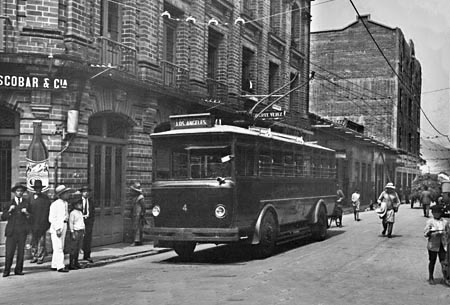in Latin America TEXT BY / ILLUSTRATIONS FROM THE COLLECTION OF
My webpage about Trolleybus Installations lists the 35 places in Latin America where trolleybus lines were built during the last 85 years. Some cities have had more than one installation. Most of these lines were built since the Second War and are documented on line and off. A dozen still operate today. The photos and text below portray the half dozen lines that opened before the War and are not so well known. They used primitive, sometimes homemade equipment. (The very first electric buses in Latin America were not trolleybuses at all but six battery-powered vehicles that J. G. Brill built for Lima, Peru, in 1904. Battery-powered buses also ran in Havana, Cuba, and in Rio de Janeiro, Brazil.) Mendoza, Argentina
Lima, Peru
They had an unusual door arrangement – one in the front and another in the center of the rear. The photo below shows a Lima trolleybus testing in England:
In 1928 trolleybuses replaced streetcars on circular route 3
Lima's trolleybus line lasted only three years. In 1931 the six trolleybuses were rebuilt as trams – and ran as weird hybrids through the 1950s:
This was the only known example in world transport history of trolleybuses converted to trams. Medellín, Colombia
Medellín trolleybus service began on 12 October 1929 on route 6, which served the Los Angeles district. Ransomes #4, below, was one of two additional trolleybuses that Medellín acquired in 1930:
TMM began building its own trolleybuses in 1934. The picture below shows homemade #5:
Nine trolleybuses were running on two routes in Medellín when TMM discontinued all electric transport in 1951. Caracas, Venezuela
Homemade trolleybus #1 was so popular that TEC made 10 more out of gasoline buses that it purchased new from General Motors in the U.S.A. The photo below shows three of these at rest, poles down, in central Caracas about 1940:
#10, below, had a single window pane in the front and a rather large TEC emblem:
The door on the left side of this trolleybus is puzzling since street traffic in Venezuela always ran right, U.S.-style. Perhaps it loaded on both sides of the town's narrow streets:
Caracas eventually had three trolleybus lines, but all closed during the rubber shortage of World War 2. The tram system survived until 1947. Santiago, Chile (1) Port of Spain, Trinidad & Tobago
Santiago, Chile (2) Pictures and data about trolleybuses in Brazilian cities are available on the website of Emídio Gardé. Links to pages about trolleybuses in Argentina, Ecuador, Mexico and Uruguay are indexed on my homepage entitled Electric Transport in Latin America. As far as is known, there were never any commercial trolleybus operations in Bolivia or Paraguay, in any of the Guianas, in any country in Central America, or on any of the other Caribbean islands.
Also see
This webpage was created by Allen Morrison Ver versión en español. Copyright © 1999-2099 Allen Morrison |












